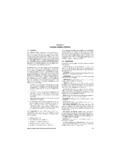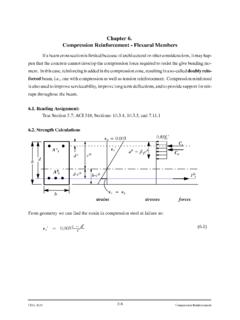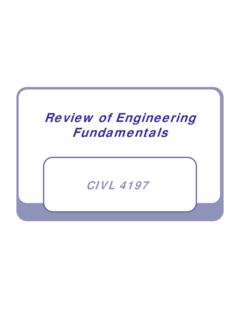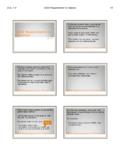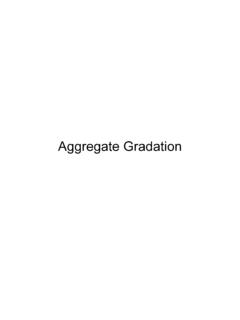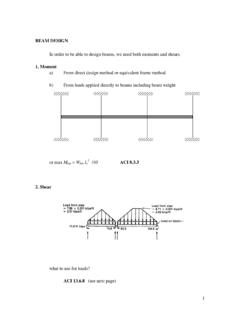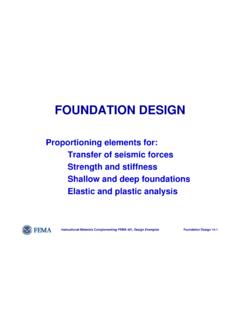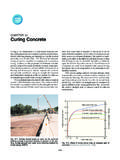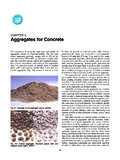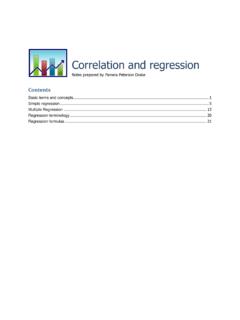Transcription of Correlation Between Continuous & Categorical Variables
1 Correlation Between Continuous & Categorical Variables CIVL 7012/8012. 2. Association Between Variables Continuous and Continuous variable Pearson's Correlation coefficient Categorical and Categorical variable Chi-square test Cramer's V. Bonferroni correction Categorical and Continuous variable Point biserial Correlation 2. Association Between Continuous Variables Compute Pearson's Correlation coefficient (r). r< , weak Correlation <r< , moderate Correlation r> , high Correlation 3. Association Between Categorical Variables Pearson's Correlation coefficient can not be applied.
2 What are some of the methods How to compute them What will be the conclusion 4. Set up hypothesis Null hypothesis: Assumes that there is no association Between the two Variables . Alternative hypothesis: Assumes that there is an association Between the two Variables . 5. Categorical variable Example: Two Categorical Variables : marital status and gender Question: How do we measure degree of association? Since these are Categorical Variables Pearson's Correlation coefficient will not work Observed Male Female Married 456 516. Widowed 58 123. Divorced 142 172. Separated 29 50.
3 Never married 188 207. 6. Reference: Pearson Chi-square test for independence Calculate estimated values Expected Male Female Observed Male Female Married Married 456 516. Widowed Widowed 58 123. Divorced Divorced 142 172. Separated Separated 29 50. Never married Never married 188 207.. , =.. 7. Calculate chi-sq for each pair (O-E)2/E Male Female Married Widowed , , . 2. Divorced , . Separated Never married Pearson Chi-square value (sum of all cells): 8. Degrees of freedom and significance Degrees of freedom = (r-1) *(c-1). In this example: (5-1)*(2-1) = 4. Significance: Chi-square ( , 4) = Reject null hypothesis Conclusion: there is an association Between the two Variables .
4 9. Cramer's V (1). Cramer's V= ( 2 / [ 1 ]). q= min (# of rows, # of columns). Cramer's V interpretation 0: The Variables are not associated 1: The Variables are perfectly associated : The Variables are weakly associated .75: The Variables are moderately associated 10. Cramer's V (2). In this case Observed> Male Female Total Not associated Married Widowed 456. 58. 516. 123. 972. 181. Divorced 142 172 314. Separated 29 50 79. Never married 188 207 395. Total 873 1068 1941. Pearson Chi-square value: # of rows (r) 5. # of cols (c) 2. q 2. Cramer's V 11. Bonferroni correction Observed Male Female Total Married 456 516 972 Expected Male Female Widowed 58 123 181 Married Divorced 142 172 314 Widowed Separated 29 50 79 Divorced Never married 188 207 395 Separated Total 873 1068 1941 Never married.
5 2 _ , =. Adjusted Residuals . , 1 1 . (O-E)2/E Male Female . Married Widowed Divorced Separated Significance level Never married # of tests 10. Adjusted sig level Only widowed male and female has significance association 12. Correlation Between Continuous and categorial Variables Point Biserial Correlation product-moment Correlation in which one variable is Continuous and the other variable is binary (dichotomous). Categorical variable does not need to have ordering Assumption: Continuous data within each group created by the binary variable are normally distributed with equal variances and possibly different means 13.
6 Point Biserial Correlation Suppose you want to find the Correlation Between a Continuous random variable Y and a binary random variable X which takes the values zero and one. Assume that n paired observations (Yk, Xk), k = 1, 2, , n are available. If the common product-moment Correlation r is calculated from these data, the resulting Correlation is called the point-biserial Correlation . 14. Point Biserial Correlation Point biserial Correlation is defined by 15. Hypothesis test 16.
